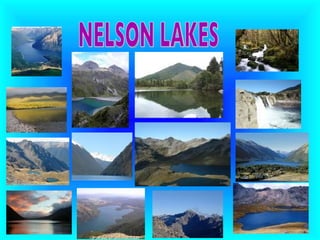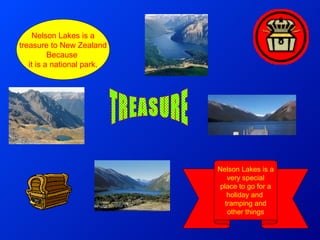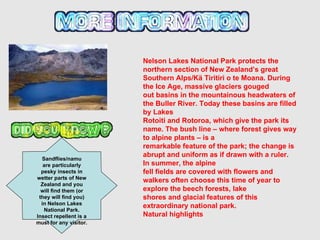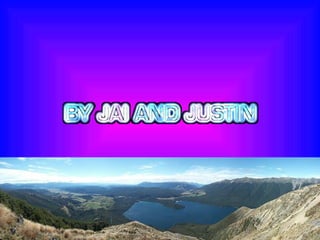Nelson Lakes
- 1. NELSON LAKES
- 2. In Maori mythology the lakes were created by the great chief Rakaihaitu digging holes with his ko , or digging stick. One hole became Lake Rotoiti, or "small waters", and the other became Lake Rotoroa, or “large waters”. Both lakes in Nelson Lakes National Park were used as food gathering places by Maori travelling to and from the West Coast to collect and trade greenstone, pounamu .
- 3. TREASURE Nelson Lakes is a treasure to New Zealand Because it is a national park. Nelson Lakes is a very special place to go for a holiday and tramping and other things
- 4. The "Revive Rotoiti Mainland Island" project ensures that visitors and locals alike can enjoy seeing a part of New Zealand which is heavily protected from pests and modification. This unique and exciting project has resulted in many species of native birds being present in larger that expected numbers. Lucky walkers may glimpse the threatened kaka and kakariki, while tuis, bellbirds and other species are found in abundance.
- 5. You will find Nelson Lakes National Park in the north of the South Island. The gateway to the park is St Arnaud, a picturesque village just one-and-a-half hours drive from Nelson or Blenheim. St Arnaud and Lake Rotoiti are accessed by State Highway 63 from Blenheim. A side road, about half way between St Arnaud and Murchison, leads to Lake Rotoroa. Bus services to St Arnaud operate on a regular basis. Water taxis operate on both lakes. Several companies offer on-demand transport to Rotoroa from St Arnaud and Nelson.
- 6. Mountaineering There are a number of good winter climbing routes suitable for experienced trampers and climbers. Hunting Deer and chamois are found in the park, particularly in the upper valleys. The St Arnaud Management Area and the Rotoiti Nature Recovery Project Area are closed to recreational hunting. Walking and tramping There are networks of short tracks exploring the forest, lake shore and glacial features of both lakes. Longer walks and alpine tramping trips are also available. The most popular are: • Travers/Sabine Circuit, an 80 km tramping track taking from 4 – 7 days, • The steep and exposed route to Lake Angelus, a beautiful alpine lake which takes 2 – 3 days. Boating, fishing and swimming Both lakes are good for trout fishing. Water-skiing is permitted on Rotoiti, within a defined area, but not Rotoroa. Speed limits apply near the foreshore. The use of personal watercraft, boats more than 8 m in length, staying overnight and mooring is not permitted
- 7. Sandflies/namu are particularly pesky insects in wetter parts of New Zealand and you will find them (or they will find you) in Nelson Lakes National Park. Insect repellent is a must for any visitor. Nelson Lakes National Park protects the northern section of New Zealand’s great Southern Alps/Kä Tiritiri o te Moana. During the Ice Age, massive glaciers gouged out basins in the mountainous headwaters of the Buller River. Today these basins are filled by Lakes Rotoiti and Rotoroa, which give the park its name. The bush line – where forest gives way to alpine plants – is a remarkable feature of the park; the change is abrupt and uniform as if drawn with a ruler. In summer, the alpine fell fields are covered with flowers and walkers often choose this time of year to explore the beech forests, lake shores and glacial features of this extraordinary national park. Natural highlights







